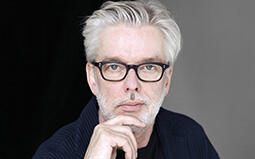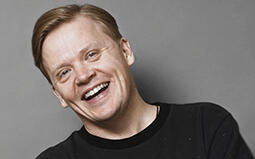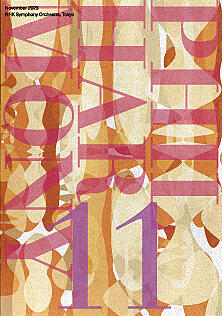- Home
- Concerts
- Subscription Concerts 2023-2024
- Program B
- No. 1996 Subscription (Program B)
Subscription Concerts 2023-2024Program B
No. 1996 Subscription (Program B)
Suntory Hall
Google Map Seating Chart

Program
Sibelius / Tapiola, symphonic poem Op. 112
The Finnish composer Sibelius’ latter life resembles that of Rossini who lived virtually in retirement for nearly four decades after completing his 39th opera William Tell (1829). Sibelius indeed bowed out as composer at the peak of his fame to hold back on full-blown creative activities for thirty odd years. He passed away at age 91 at his house surrounded by nature in Järvenpää, Finland. During this silent period, he penned the Symphony No. 8 but threw it away unfinished through self-criticism. Therefore, the symphonic (tone) poem Tapiola is left to us as his last major work he completed and published. It was composed in 1926 to be premiered the same year in New York. Incidentally, his last symphony (No. 7) had been first performed back in 1924.
The title of the symphonic poem stands for the domain of Tapio, the Finnish mythological god of forests mentioned in the Kalevala (Finland’s national epic which inspired several works of Sibelius). The published score of Tapiola was prefaced with the following quatrain authorized by the composer:
Wide-spread they stand, the Northland’s dusky forests,
Ancient, mysterious, brooding savage dreams;
Within them dwells the Forest’s mighty God,
And wood-sprites in the gloom weave magic secrets.
Tapiola is highly valued for its meticulously elaborated motivic development: at the outset over timpani rumbling, strings state a nine-note motif which would be restated repeatedly in different forms and generate other main motifs/themes heard later.
[Kumiko Nishi]
Stravinsky / Violin Concerto in D
Music historians have dubbed Stravinsky “Chameleon,” for the Russia-born cosmopolitan composer changed styles drastically and frequently. A pupil of Rimsky-Korsakov in Saint Petersburg, Stravinsky produced a great sensation in 1913 in Paris with his so-called “primitivistic” music for the modern ballet, The Rite of Spring. He then wrote in 1920 a score for the ballet Pulcinella: this epochal composition, this time, marked the start of musical neo-classicism, an important movement to revive idioms and aesthetics of the 17th and 18th centuries in modern lights.
Violin Concerto in D is also from Stravinsky’s neo-classic period. He composed it in 1931 in France taking some technical advice from the Polish American violinist Samuel Dushkin who would premiere it. The titles of all four movements already express clearly the influence from forms omnipresent in Baroque music: Toccata, Arias and Capriccio. Stravinsky even admitted that the dialogue between the soloist and the concertmaster (the lead violinist of the orchestra) heard during the final Capriccio was inspired by the first movement of J. S. Bach’s Concerto for Two Violins BWV1043.
For the unity of the work, Stravinsky opens every movement with a dissonant chord with three notes (D, E, A) large-intervals apart. While metric and rhythmic variability distinguishes joyous I Toccata, virtuosic IV Capriccio is characterized by its syncopated rhythms (displacements of accents) and rural mood. The inner Arias are rare opportunities for listeners to savor the composer’s lyrical and even introspective sides.
[Kumiko Nishi]
Sibelius / Symphony No. 1 E Minor Op. 39
Finland’s timeless hero, Sibelius established the country’s national identity in music. After studying abroad in Berlin and Vienna, the composer in his late twenties sprung into fame domestically with the 1892 premiere in Helsinki of Kullervo, a symphonic piece for voices and orchestra based on the above-mentioned epic Kalevala. He went on writing nationalist tone poems such as The Swan of Tuonela (1895/1897/1900) and Finlandia (1899/1900). Interestingly enough, he derived inspiration from the country’s nature, history or literature, rather than quoting actual folk songs like so many patriotic composers.
Contemporary with Finlandia, Symphony No. 1 is purely instrumental with no explicit program. This composition was Sibelius’ first step as a symphonist in the pan-European tradition, another important face of him. His six completed symphonies would follow after it to greatly enhance 20th-century music history, for most of his colleagues of the time turned their back on the genre seemingly anchored by Bruckner and Mahler.
Sibelius began sketches of No. 1 in 1898 while travelling in Berlin and returned home to complete it in 1899. Following the first performance in the same year in Helsinki, he made amendments to the score. This definitive version, premiered in 1900 in the capital, was published in 1902. Although including harp and tuba, the instrumentation is closer to that of the symphonies of Beethoven and Brahms than, for instance, Mahler’s No. 5 penned in 1901–1902.
Sibelius’ No. 1 has outer movements echoing each other: the both commence with the slow Andante introductions in E minor on the same theme which is first heard as a lone clarinet tune at the outset of the symphony. Moreover, the both movements end similarly with two pizzicato chords on strings. The gentle second movement surprises us with its second theme given by bassoons and other winds in an antique fugal manner. The third movement starting with, again, string pizzicato chords over which timpani pounds the main theme, reminds us of Bruckner’s vehement scherzos.
[Kumiko Nishi]
[Encore]
Nov. 15: Finnish Folk Music / KOPSIN JONAS
Nov. 16: Iro Haarla (arranged by Pekka Kuusisto) / Barcarole
Violin: Pekka Kuusisto
Artists
 ConductorJukka-Pekka Saraste
ConductorJukka-Pekka Saraste
Jukka-Pekka Saraste, born in Heinola, Finland, started his career as a violinist before studying conducting under Jorma Panula at the Sibelius Academy in Helsinki to shift his direction, and now he is one of the world’s most renowned conductors. He is particularly known for works of the late Romantic period as well as contemporary music, giving the world premiere performances to works by Wolfgang Rihm, Friedrich Cerha and Pascal Dusapin. In 1983, together with Esa-Pekka Salonen, he launched the Avanti! Chamber Orchestra, an ensemble specialized in modern music.
The positions he has served till now include Principal Conductor of the Scottish Chamber Orchestra, the Finnish Radio Symphony Orchestra, Chief Conductor of the WDR Symphony Orchestra in Cologne, Music Director of the Toronto Symphony Orchestra, and Music Director and Chief Conductor of the Oslo Philharmonic Orchestra. He assumed the position of Principal Conductor and Artistic Director of the Helsinki Philharmonic Orchestra in the summer of 2023. He also founded the Finnish Chamber Orchestra and its Tammisaari Festival where the orchestra plays the main part. In recent years, he has also injected his energy into an educational program designed to inspire young musicians called LEAD! The Orchestra Project, which he co-founded.
Our expectations on his appearance are rising, as we will have the opportunity to hear Stravinsky Violin Concerto with Pekka Kuusisto and Sibelius Symphony No. 1, which he would have conducted in the unfortunately cancelled subscription concert of Program C in June 2020.
[Ryosuke Masuda, music critic]
 ViolinPekka Kuusisto
ViolinPekka Kuusisto
Finnish violinist Pekka Kuusisto enjoys an outstanding repertoire ranging from Bach to contemporary works and to jazz and folk music, employing a highly expressive playing style. In recent years, he has worked with the Chicago Symphony Orchestra, the Swedish Radio Symphony Orchestra and the Tokyo Metropolitan Symphony Orchestra, and was named as the Philharmonia Orchestra’s Featured Artist. He injects much of his energy in conducting while also playing as a soloist as well as serving as a leader to ensembles. He has assumed the positions of Principal Guest Conductor and Artistic Co-director of the Helsinki Philharmonic Orchestra this season. Born in 1976, he is from a musical family with both his grandfather having been and his father being renowned composers, while his elder brother Jaakko, who passed away in 2022 at the untimely age of forty-eight, was a distinguished violinist. Pekka Kuusisto studied at the Sibelius Academy in Helsinki and Indiana University, and became the first Finn to win the International Jean Sibelius Violin Competition in 1995. Stravinsky’s Violin Concerto, which he plays in a dignified sound and manner, is his favorite work, and he has played it with the Philharmonia Orchestra under Santtu-Matias Rouvali. This is his first appearance with the NHK Symphony Orchestra.
[Yoshimichi Okuda, music critic]
Download
Ticket
Program B
No. 1996 Subscription (Program B)
Suntory Hall
Google Map
Seating Chart
Single Tickets Release Date
Pre-sales for Subscribers:Thursday, July 27, 2023
*about subscribers
Sale to General Public:Sunday, July 30, 2023
Price
| S | A | B | C | D | |
|---|---|---|---|---|---|
| Ordinary Ticket | 9,800 | 8,400 | 6,700 | 5,400 | 4,400 |
| Youth Ticket | 4,500 | 4,000 | 3,300 | 2,500 | 1,800 |
Seating chart Enlarge Print PDF
*tax included
*Subscribers receive a 10% discount (Available at NHKSO WEB Ticket and N-Kyo Guide)
*For wheelchair-accessible seats, please refer to the N-Kyo Guide
Youth Tickets
Youth Tickets are great options for those of 25 years old and younger
Subscription tickets
Release Date
ANNUAL SUBSCRIPTION TICKETS
Mon., July 17, 2023 10:00am
[For Subscribers: Sun., July 9, 2023 10:00am]
For further information and
subscription application
*Repertoire, conductor, soloists and program order are subject to change without notice.
*Pre-school children are not allowed in the concert hall


